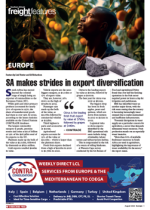The trade balance between South Africa and the European Union (EU) has moved in South Africa’s favour since the SADC EPA came into effect in June 2016.According to EU statistics, the balance of trade was around €6.4 billion in the EU’s favour, with the EU exports valued at €206bn and imports from SA at €14.2bn. By 2021 the f low had moved to €104 million in South Africa’s favour, followed by €2.9bn in 2022, when SA exports hit a high of €29.2m.However, in 2023 the balance tilted back to the EU, at €2.7bn.EU exports to SA totalled €26bn and imports from SA €23.1bn which, although a drop from 2022, was the second-highest value.This ref lects economic stagnation in the EU, which narrowly avoided ending 2023 in recession.According to Eurostat, GDP rose just 0.5% both in the Eurozone and the EU during 2023.Other SADC signatories to the SADC EPA have benefited more from the agreement.The EU statistics show that the SADC region as a whole had a positive trade balance of €16.2bn in 2022 and €6.5bn in 2023.EU imports from the SADC group hit a high of €48.8bn in 2022, dropping to 37.5bn in 2023.Countries benefiting from the SADC EPA are SA, Botswana, Lesotho, Mozambique, Namibia and Eswatini. The other six members of the Southern African Development Community region are incorporated in or negotiating EPAs with the EU as part of other regional groups, namely central Africa or eastern and southern Africa.Botswana, Lesotho, Mozambique, Namibia and Swaziland enjoy 100% duty- and quota-free access to the EU, while 98.7% of SA exports are exempted, but subject to quantity quotas.

